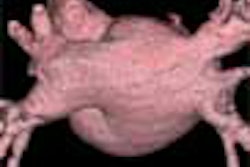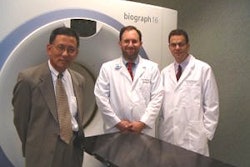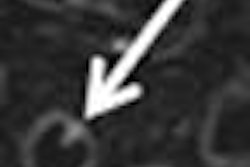Great Britain, which gave the world CT technology only to lag in its implementation, is making up for lost time. Thanks to a massive increase in funding since 1997, the cherished but perenially troubled National Health Service is beginning to show real progress.
In July the U.K. government confirmed that by 2007-2008, the service will wield an annual budget exceeding 90 billion pounds a year ($164.5 billion). The budget will be three times the outlay of 1997, the year Prime Minister Tony Blair vowed to save the NHS, and not incidentally, create the most modern CT installed base in Europe.
The National Health Service's improvements are perhaps most apparent in radiology -- especially in CT. MDCT scanners and radiology staff are rapidly being added. CT utilization has increased rapidly since 2000, when the U.K.'s population of 58 million people muddled through on a total of 250 CT scanners, most of them single-slice.
"Since CT was first discovered in the U.K. by (Sir Godfrey) Hounsfield's invention, it has been disquieting in the U.K. that we really have diffused the technology very slowly," said Dr. Adrian Dixon, professor of radiology at the University of Cambridge and honorary consultant radiologist at Addenbrooke's Hospital in Cambridge, U.K. Dixon also served as a member of the Partners Council of the National Institute of Clinical Excellence from 1999-2002, and was recently elected warden of the Royal College of Radiologists.
"There were rather too few CT systems in the country, and some of them were getting quite old," Dixon said in a talk at the 2004 International Symposium on Multidetector-Row CT in San Francisco. He said many of the CT scanners were initially installed by charities, and there was no formal replacement program.
Things are looking better now. The addition of imaging equipment and staff have been high priorities in the government's push to improve the NHS, though there are complaints that improvements promised and paid for have yet to make their way to the front lines of care.
The push for CT has been driven in part by a desire to scan cancer patients more quickly -- 2.2 billion pounds have been spent just to improve cancer treatment in the past three years, Dixon said. To tie it all together, the NHS is building the world's largest integrated PACS system.
"In 2004 there will be 400 CT units; 50% of the units will be MDCT, which is rather ahead of America," Dixon said, noting that the number of training places in radiology has increased by 25% over the last three years. But in his institution, he said, increasing demand for imaging services, and CT in particular, means the radiologists just keep getting busier.
British Department of Health statistics note that the number of CT scans has risen by 50% since 1997, with nearly 1.8 million diagnostic CT scans performed for the reporting year ended April 2003. Virtually all cancer patients referred for urgent treatment are now seen within two weeks.
The growing availability of MDCT scanners in the U.K. -- an initiative that has been funded largely by lottery money rather than traditional NHS funding sources -- is rapidly changing the practice of medicine in a number of ways, Dixon said. And while overall resources are certainly rising, to understand the NHS is to know that other areas will have to be tapped if the CT boom is to continue apace.
"If you do more MDCTs ... somebody, somewhere, has to give up some money to accommodate it," he said.
CT for what ails you
The 1,000-bed facility at which Dixon serves as clinical director of radiology, Addenbrooke's NHS Trust, now has three CT scanners including a single-slice machine, a 16-slice, and a four-slice scanner due to be replaced by a 64-slice machine later this year. And while the number of applications for CT keeps expanding, the staff numbers have not kept pace, he said.
"A tremendous amount of work has emerged, and as a result we have a huge shortage of radiologists and radiotechnicians," he said. "Where is the transfer of people who used to do clinical exams into imaging? As CT is widely used now in place of physical examination -- let's be honest -- where is the transfer of those people who used to palpate the spleen? Where is that transfer of resources coming into radiology?"
Pulmonary embolism
Even single-slice CT has proved to be quite effective for diagnosing pulmonary embolism. Unfortunately, the success at Cambridge has been rewarded with a seemingly endless supply of suspected pulmonary embolism (PE) patients, taking up scanner and radiologist resources that were intended to benefit cancer patients, Dixon said. As a result, the scanners are being filled with older and older patients with increasingly poor clinical indications for CT.
"The strike rate for positive PE is going down, down, down," Dixon said. "(CT) is becoming a screening test for anyone who is remotely breathless or coughing. So this is a big problem ... one good thing in the U.K. is that because nuclear medicine and CT are all vaguely in the same area, it's possible to shift resources from one area to another, so we may be able to decrease VQ scintigraphy without upsetting too many people, and be able to use that staff to build PET/CT -- that is one of the hopes."
Stroke
Perfusion imaging for suspected acute stroke is another important application that is certain to grow, given the growth of new CT imaging techniques, and the success of thrombolytic therapy applied soon after the acute ischemic event, Dixon said. According to NHS statistics, the number of hospitals with specialized stroke units has increased from 45% to 73% over the past four years.
"The usefulness of MDCT has changed the practice of stroke, because one can get straight in and do the 3D dataset," Dixon said. Perfusion imaging is completed within an hour, "patients are (spared) having to have the angiogram, and that will make a lot of improvement." CT for head trauma is another important application, of course.
Abdomen
The ability to scan the entire abdomen in a single CT session gives the modality a huge advantage over radiography, Dixon said. Extra workstations the government has purchased with each scanner allow the radiologists to review the 3D datasets (no time-consuming axial images, please) in peace and quiet.
"We know that the appendix can be anywhere in the abdomen, and that's a huge advantage for CT when you can see these strange appendices going into the hepatic flexure," he said, citing a randomized trial of acute abdominal problems in the U.K. The study showed that by every measure -- outcomes, length of hospital stay, mortality -- CT was superior to radiography, he stated. Still, he said, for most applications MDCT hasn't added much diagnostic power over single-slice.
"MDCT certainly allows you to make diagnoses that you couldn't make so easily on single-slice, like superior mesenteric artery thrombus," Dixon said.
MDCT can make a good replacement for standard skeletal scintigraphy as well, he said. Neither test is perfect, but the CT approach is especially efficient when the patient is coming to the CT scanner anyway, perhaps for cancer staging. In any case, scintigrams can be read much more quickly than CT, but CT finds more lesions, he said, and PET/CT brings even more advantages.
Finally, he said, the use of whole-body CT has not been adopted by the U.K. government; in fact, the national cancer screening committed has spoken against it.
"I have (also) spoken against it, because in a cash-constrained society, if we open this up, where do the radiologists come from? Where do the techs come from?" Dixon said. "And we will find it even more difficult to give those urgent CT head (scans) in the middle of the night."
By Eric Barnes
AuntMinnie.com staff writer
August 10, 2004
Related Reading
U.K. PACS initiative aims for community-wide image management, June 25, 2004
View from the president: Professor Helen Carty scans ECR 2004, March 4, 2004
Britain plans to update cancer technology, May 23, 2003
Incidence of cancer rising fast in UK, while mortality declines, December 23, 2002
The parlous state of UK radiology, September 24, 2002
Copyright © 2004 AuntMinnie.com



















